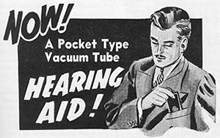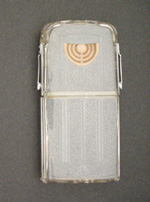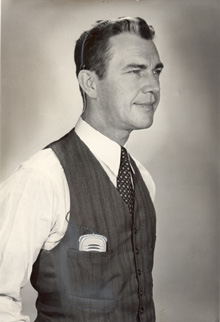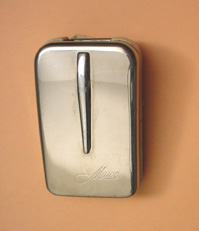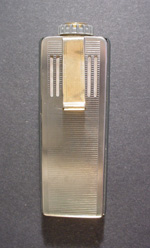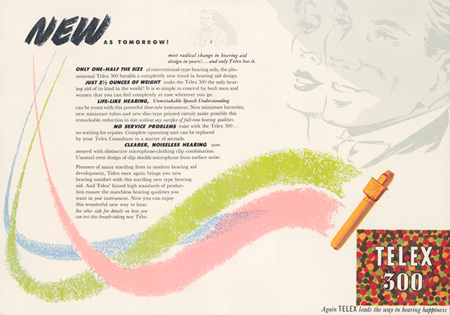Single Page View
Concealed Hearing Devices of the 20th Century
By 1947 advancements in battery technology led to even more dramatic size reductions. Now, the microphone, amplifier, and batteries could be packaged in one unit with a single cord to the earpiece.
|
Zenith Model 75, 1947 |
| The Zenith Model 75 represents one of the earliest models incorporating the microphone, amplifier, three vacuum tubes and batteries within a single unit. The list price of the Model 75 was $75.00, a low price that Zenith advertisements emphasized. |
| View an Object VR movie of the Zenith Model 75 |
Hearing aids that fit into a shirt pocket or clipped to a lapel were the first all-wearable styles, housing the batteries, small vacuum tubes, amplifier and microphone into the same casing. These devices were usually directed toward men, who often wore suits, ties, and shirts with pockets which allowed for concealment. Pocket aids included a tie or pocket clip with an insignia to camouflage the microphone.
 |
| Tie Clip Models |
| Hearing aids that clipped to a tie or a lapel were among the first all-wearable models of hearing aids. |
|
|
| Hal-Hen Hearing Aid Klip |
| The Hal-Hen Men's Hearing Aid Klip was designed to fasten to two buttons on a man’s shirt. The elastic strap securely held a hearing aid in place under a tie. |
|
© Hal-Hen Company, Inc. |
|
|
| This photograph demonstrates how a “pocket aid” could be discreetly tucked into one’s pocket. |
|
|
| Maico Model J “Top Secret,” 1950 |
| This small hearing aid measured just 1-7/8 inches by 2-7/8 inches and could be easily concealed in a pocket. The microphone was on top of the device, thus eliminating the unwanted noise from the microphone rubbing against clothing. |
|
|
|
|
| Sonotone Model 940, 1950 |
| This slim-styled vacuum tube hearing aid was introduced by Sonotone in 1950. The 940 could be worn underneath a man’s clothing, with a separate microphone – disguised as personal jewelry – worn outside the clothing. |
| |
|
Courtesy of Sonotone |
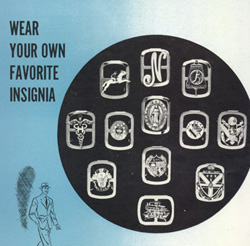 |
Decorative insignia to disguise microphones |
| Sonotone’s brochure for the Model 940 illustrated a number of decorations that could be used to decorate and disguise the outside of a microphone. Examples given included “fraternal, service club, Legion, war service insignia, union or church buttons, or any favorite ornament having a flat back.” |
Courtesy of Sonotone |
|
Among the more ingenious attempts at concealment of hearing aids were watches and pens.
| Acousticon “Wrist-Ear” |
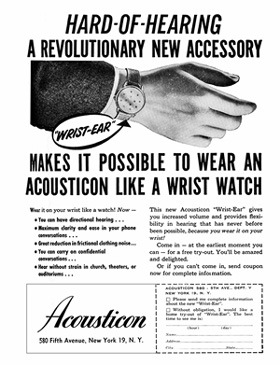 |
| The Acousticon “Wrist-Ear,” produced around 1955, was advertised as a “revolutionary new accessory” as seen in this ad. Cords for the wristwatches were concealed under the sleeves. |
|
Telex Fountain “Pen” |
| The Telex 300 was produced in 1950 and, according to the ad, was a “precedent shattering” model “to help keep your hearing loss a secret from all the world.” |
Reprinted from The Hearing Journal 50 (11) 1997, p.43,
with the permission of Lippincott, Williams and Wilkins |
|
|
Courtesy of Telex Communications |
“Five million Americans need hearing aids. Yet only 1,250,000 wear them! Why is this? A recent survey revealed nine different reasons; the principal one is vanity.”
— Leonard Davis, American Hearing Aid Association, 1955
Continued
<< Previous | 1 | 2 | 3 | 4 | 5 | 6 | Next >>
